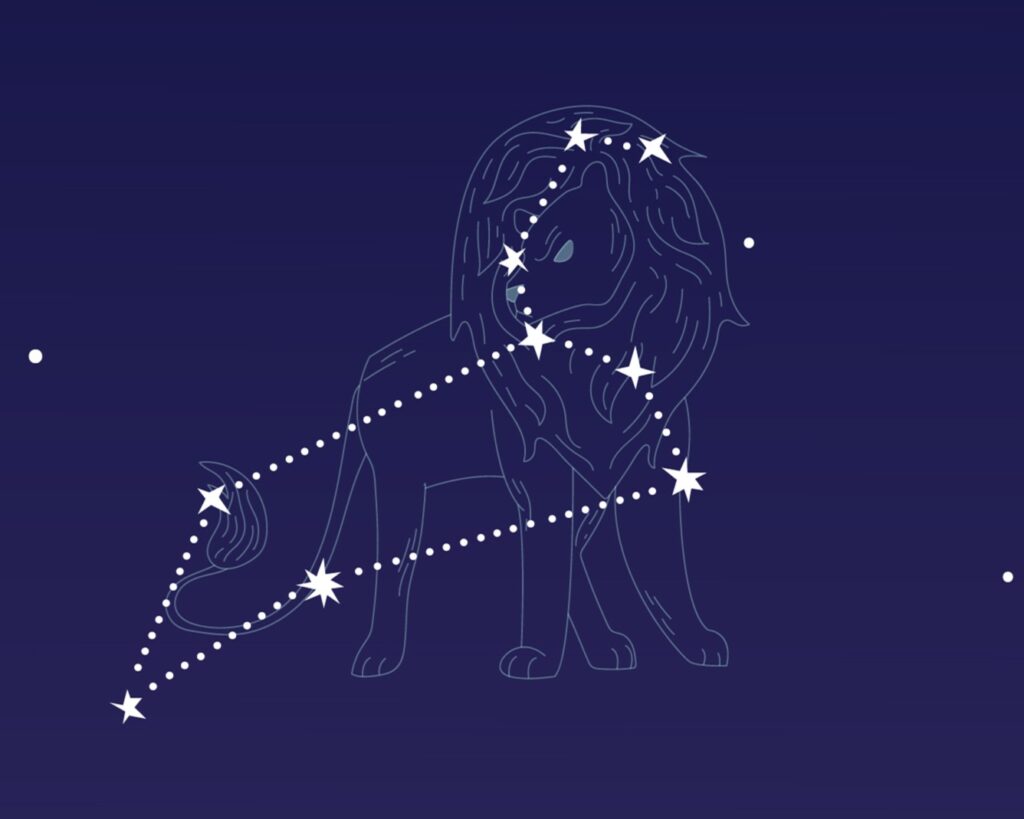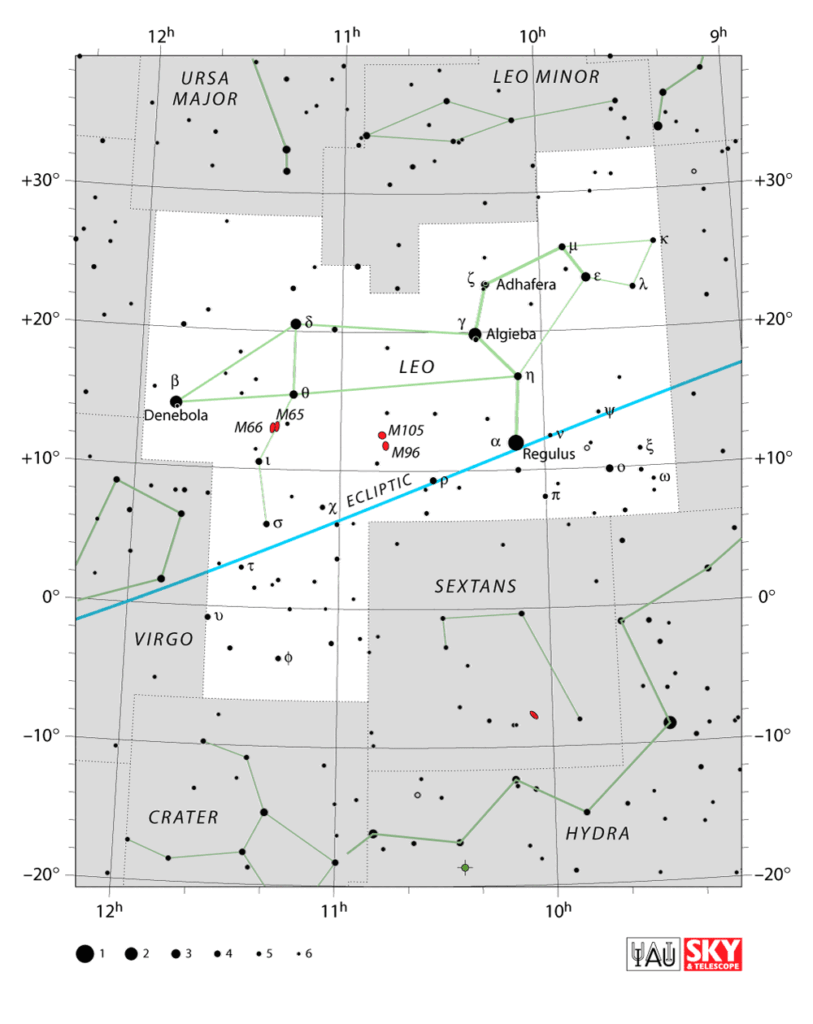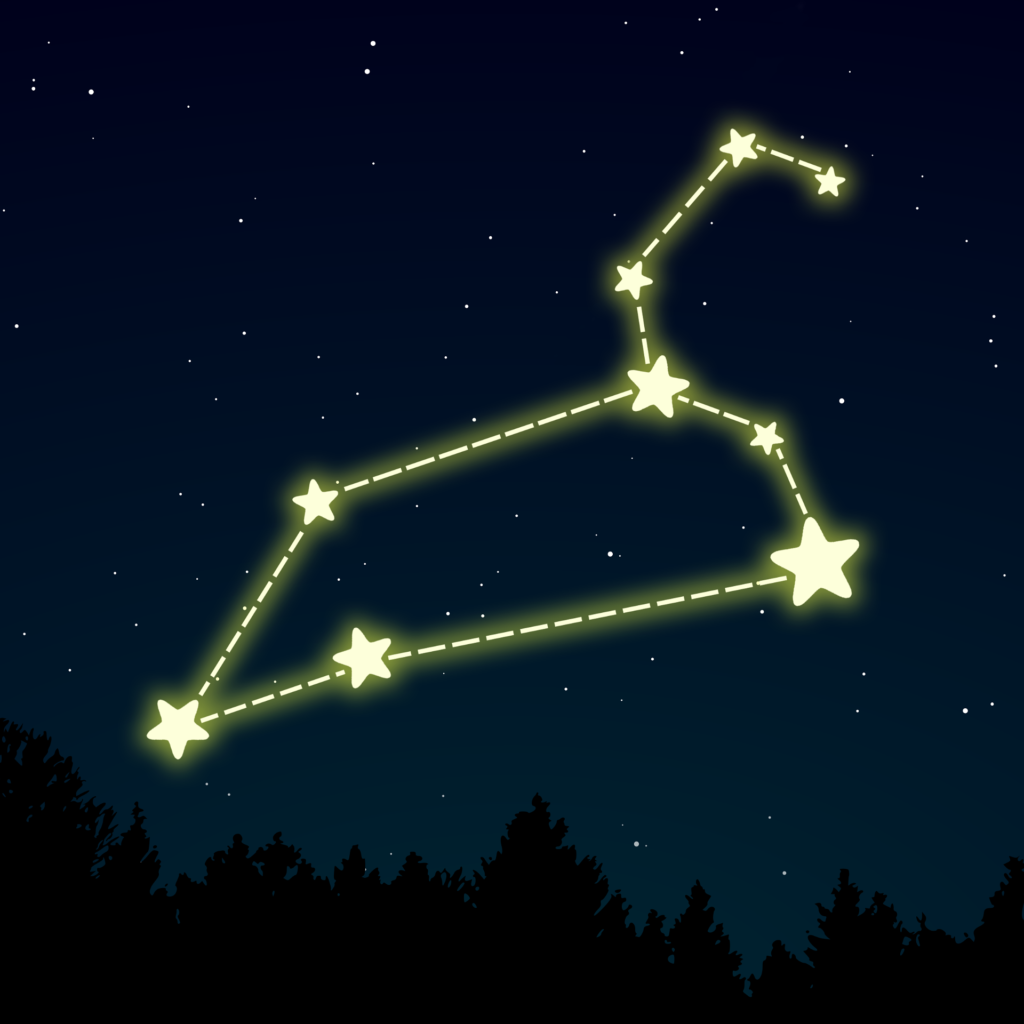Stargazing with Leo
© freepik/tartila
The Leo constellation, often referred to as “The Lion,” is a prominent and easily recognizable constellation in the night sky. It is one of the 88 officially recognized constellations and holds a significant place in both ancient mythology and contemporary astronomy. Positioned along the ecliptic between Cancer the crab to the west and Virgo the maiden to the east, the lion constellation is part of the zodiac, playing a pivotal role in astrological traditions.
The constellation is home to several bright stars, including Regulus, which is one of the brightest stars in the night sky. The constellation is commonly represented as if the sickle-shaped asterism of stars is the back of the Lion’s head. Rich in celestial lore, the constellation is associated with various myths and legends from different cultures, often symbolizing strength and royalty. Beyond its cultural significance, Leo also contains fascinating astronomical features, such as star clusters and galaxies.
Leo ranks as the 12th largest constellation, covering an expansive area of approximately 947 square degrees in the night sky. Positioned in the second quadrant of the northern hemisphere (NQ2), the constellation is observable at latitudes ranging from +90° to -65°. As one of the 15 equatorial constellations, the lion constellation is adorned with 14 named stars. The International Astronomical Union (IAU) officially recognizes the proper names of these stars, which include Adhafera, Algieba, Alterf, Chertan, Denebola, Dingolay, Formosa, Moriah, Noquisi, Rasalas, Regulus, Sagarmatha, Subra, and Zosma.
HISTORY OF LEO

The constellation has a rich history deeply embedded in the mythology and cultural narratives of ancient civilizations. Its prominence along the ecliptic, the apparent path of the Sun across the celestial sphere, made it a significant component of early astronomical observations.
In Greek mythology, Leo is often associated with the Nemean Lion, a formidable creature slain by Hercules as one of his Twelve Labors. The lion’s hide, said to be impervious to weapons, became Hercules’ protective cloak. The Greeks honoured this mythological connection by placing the lion in the night sky as the constellation.
In ancient Egypt, the constellation was linked to the goddess Sekhmet, a powerful deity with leonine attributes. Sekhmet was considered both a protective force and a fierce warrior. The association of the constellation with this lioness goddess reflected qualities of strength and royalty.
The Babylonians also recognized Leo in their celestial observations, associating it with the “Great Lion” and incorporating its presence into their astrological practices. The constellation’s appearance during significant celestial events, such as the vernal equinox, contributed to its perceived influence in the zodiac.
As astronomy evolved, the Leo constellation continued to play a central role. Its bright stars, including Regulus, were essential for navigation and timekeeping. Regulus, also known as the “Heart of the Lion,” is one of the brightest stars in the night sky and has been a guiding beacon for mariners and travellers throughout history.
ASTRONOMICAL FEATURES

The Leo constellation boasts several fascinating astronomical features that contribute to its allure in the night sky:
ALPHA LEONIS
Regulus, identified as Alpha Leonis, serves as the most brilliant star within the constellation, claiming a prominent position in the night sky. Recognized as the “Heart of the Lion,” Regulus is a complex multiple star system, comprising four individual stars. Its radiant luminosity not only renders it easily distinguishable to observers but also designates it as a crucial navigational landmark with historical significance. Regulus plays a pivotal role in forming the distinctive sickle-shaped pattern, resembling a backward question mark, that outlines the head and majestic mane of the celestial lion within the constellation.
This celestial beacon also harbours a system of exoplanets, contributing to our understanding of planetary systems around bright stars. Whether admired for its cultural significance, its contribution to celestial formations, or its role in ongoing astronomical discoveries, Regulus remains a captivating and iconic element of the cosmic tapestry.
THE SICKLE
The Sickle is a distinctive asterism within the Leo constellation, forming a backward question mark or sickle-shaped pattern that outlines the head and mane of the celestial lion. At the base of the sickle lies the bright star Regulus, known as the “Heart of the Lion.” This recognizable arrangement of stars adds to the visual allure of the constellation, making it easily identifiable in the night sky. The Sickle is a prominent feature that has captured the imaginations of skygazers throughout history, contributing to the cultural and astronomical significance of the constellation.
MESSIER 65, MESSIER 66, AND NGC 3628
The Leo Triplet, consisting of Messier 65, Messier 66, and NGC 3628, forms a captivating trio of interacting galaxies within the Leo constellation. These spiral galaxies are gravitationally bound to each other, creating a stunning celestial tableau. Messier 65 and Messier 66 showcase well-defined spiral arms, while NGC 3628 exhibits a more edge-on orientation, revealing its flattened disk structure. This galactic trio, situated approximately 35 million light-years from Earth, offers a mesmerizing sight for astronomers and astrophotographers. The Leo Triplet is a compelling example of galactic interactions and serves as a remarkable feature in the cosmic landscape of the constellation.
NGC 2903
NGC 2903 stands as a noteworthy barred spiral galaxy located within the constellation. This celestial beauty showcases distinct spiral arms and a central bar structure, adding to its captivating appearance. Approximately 30 million light-years distant from Earth, NGC 2903 is a popular target for amateur astronomers equipped with telescopes. Its well-defined features make it a compelling subject for observation and astrophotography, contributing to the celestial wonders that enrich the cosmic tapestry within the Leo constellation.
LEO I AND LEO II DWARF GALAXIES
Leo I and Leo II are two dwarf galaxies that belong to the Local Group, a collection of galaxies that includes the Milky Way. Located in the constellation, these dwarf galaxies are relatively small and faint compared to their larger cosmic counterparts. Leo I is positioned about 820,000 light-years from Earth, while Leo II is situated at a slightly greater distance of around 912,000 light-years. Despite their diminutive size, these galaxies contribute valuable insights into the dynamics and evolution of galactic structures within the cosmic neighbourhood. Studying dwarf galaxies like Leo I and Leo II aids astronomers in understanding the broader context of galactic interactions and the intricate web of relationships within the vast cosmic landscape.
REGULUS AND ITS EXOPLANETS
Regulus hosts a fascinating planetary system. This multiple-star system contains at least four exoplanets. These planets, orbiting Regulus, contribute to our understanding of planetary systems around bright stars. The study of exoplanets in the Regulus system provides astronomers with valuable data to explore the diversity of planetary compositions, orbital dynamics, and the broader context of planetary formation in the universe. Regulus, with its planetary companions, stands as a compelling subject for ongoing astronomical research, shedding light on the intricacies of stellar systems beyond our solar neighbourhood.
VISIBILITY AND SEASONALITY

The visibility and seasonality of the Leo constellation offer a dynamic journey through the night sky, influenced by Earth‘s orbital dance around the Sun. Whether gracing the heavens in spring for Northern Hemisphere observers or winter for those in the Southern Hemisphere, the celestial lion, reveals itself at specific times of the year. Understanding the ebb and flow of the constellation’s visibility enhances the stargazing experience, inviting skygazers to appreciate the cosmic ballet that unfolds with the changing seasons.
NORTHERN HEMISPHERE
- Spring: Leo is prominent in the eastern sky during the spring months. As the night progresses, it ascends higher and becomes well-placed for observation.
- Summer: While still visible in the early summer, Leo gradually moves toward the western horizon as the night progresses.
- Autumn: By autumn, Leo becomes less visible in the night sky, eventually setting in the west.
- Winter: Leo is not typically visible during the winter months for Northern Hemisphere observers.
SOUTHERN HEMISPHERE
- Autumn: Leo begins to rise in the eastern sky during the autumn months and becomes more visible as the night progresses.
- Winter: Leo is well-placed for observation during the winter months, reaching its highest point in the northern sky.
- Spring: While still visible in the early spring, Leo gradually moves toward the western horizon.
- Summer: Leo becomes less visible during the summer months for Southern Hemisphere observers.
METEOR SHOWER

The Leonids meteor shower is one of the most well-known and highly anticipated meteor showers that occurs annually. It is associated with the comet Tempel-Tuttle, and the shower gets its name because its radiant—the point in the sky from which the meteors appear to originate—is located within the Leo constellation.
These meteor shower are known for producing bright and fast meteors with persistent trails, making them a spectacular sight for observers. The shower is particularly famous for its periodic “meteor storms,” where the rate of meteors can be exceptionally high, producing hundreds or even thousands of meteors per hour. These storms occur when the Earth passes through a dense debris trail left behind by Comet Tempel-Tuttle.
The peak of the meteor shower typically occurs around mid-November each year. During this time, observers can witness an increased frequency of meteors, and the shower is often more active in years when the comet has recently passed through the inner solar system.
One of the most famous meteor storms associated with the Leonids occurred in 1833 when observers reported an incredible display of thousands of meteors per minute. While such intense meteor storms are rare, the Leonids remain a favourite among stargazers and astronomers alike.
To observe this meteor shower, it’s recommended to find a location away from light pollution, lie back, and look towards the radiant point in the Leo constellation. Patience is key, as meteor showers can have periods of lull followed by bursts of activity.
